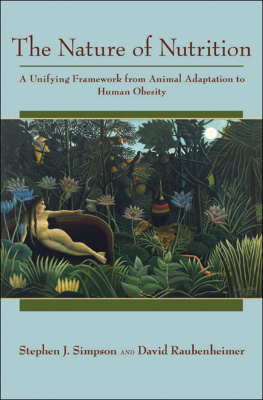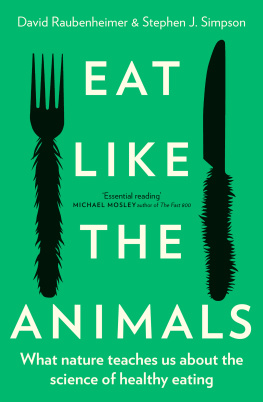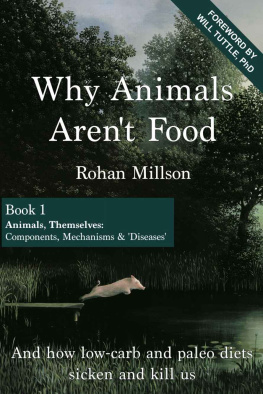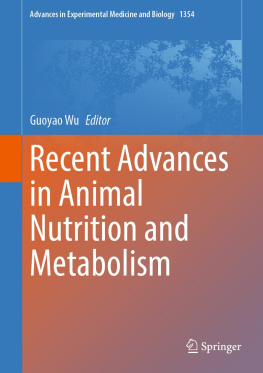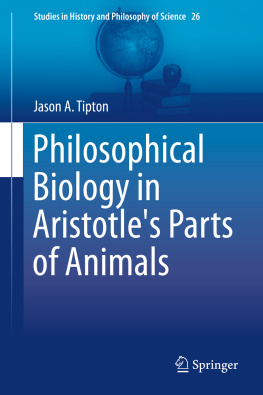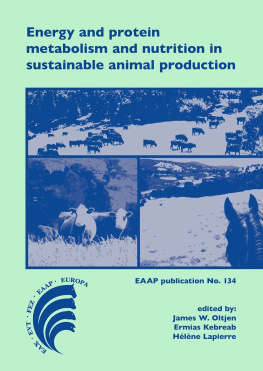The Nature of Nutrition
The Nature of Nutrition
A UNIFYING FRAMEWORK FROM ANIMAL ADAPTATION TO HUMAN OBESITY
Stephen J. Simpson and David Raubenheimer
PRINCETON UNIVERSITY PRESS
Princeton and Oxford
Copyright 2012 by Princeton University Press
Published by Princeton University Press, 41 William Street, Princeton, New Jersey 08540
In the United Kingdom: Princeton University Press, 6 Oxford Street, Woodstock, Oxfordshire OX20 1TW
press.princeton.edu
Jacket Art: Henri Rousseau, The Dream, 1910, oil on canvas. Digital image The Museum of Modern Art/Licensed by SCALA/Art Resource, NY
All Rights Reserved
Library of Congress Cataloging-in-Publication Data
Simpson, Stephen J.
The nature of nutrition : a unifying framework from animal adaptation to human obesity / Stephen J. Simpson and David Raubenheimer.
p. cm.
Includes bibliographical references and index.
ISBN 978-0-691-14565-5 (hardback : alk. paper) 1. Nutrition. 2. NutritionResearch. 3. Animal nutrition. 4. Adaptation (Physiology) 5. Bioenergetics. 6. Physiology, Experimental. 7. Obesity. 8. Energy metabolism. I. Raubenheimer, David, 1960 II. Title.
QP141.S534 2012
612.3dc23 2011042321
British Library Cataloging-in-Publication Data is available
This book has been composed in Sabon LT Std
Printed on acid-free paper. 
Printed in the United States of America
10 9 8 7 6 5 4 3 2 1
Contents
Acknowledgments
We would like to Express our thanks to all of our students, postdoctoral associates, and colleagues, many of whom are named in the book at the points where we discuss their work. Pedro Telleria-Teixeira provided invaluable support in preparation of the manuscript, and various chapters were read and commented upon by Fiona Clissold, Arthur Conigrave, Audrey Dussutour, Annika Felton, Alison Gosby, Ron Moorhouse, Jessica Rothman, Alice Tait (ne Coveney), Shawn Wilder, and Ken Wilson. Thanks too to the funding agencies that have supported our research over the years, including the Australian Research Council, Australian National Health & Medical Research Council, Marsden Fund, Massey University Research Fund, National Research Centre for Growth and Development (NZ), The University of Sydney, UK Biotechnology and Biological Sciences Research Council, UK Engineering and Physical Sciences Research Council, UK Natural Environment Research Council, UK Medical Research Council, United Nations Development Programme, and the European Union COST Action Programme. We owe a considerable debt to the Wissenschaftskolleg zu Berlin (WIKO) for hosting us during a stimulating year in which this book was germinated. Finally, heartfelt thanks to our families: to Lesley, Nicholas, and Alastair Simpson, and to Jacky, Gabriel, and Julian Raubenheimer.
The Nature of Nutrition
ONE
Nutrition and Darwins Entangled Bank
Charles Darwin (1859) famously ended his revolutionary book TheOriginofSpecies with a paragraph that opened:
It is interesting to contemplate an entangled bank, clothed with many plants of many kinds, with birds singing on the bushes, with various insects flitting about, and with worms crawling through the damp earth, and to reflect that these elaborately constructed forms, so different from each other, and dependent on each other in so complex a manner, have all been produced by laws acting around us.
Darwin demonstrated in his book that a few biological factswhat he refers to as lawscombine to provide an elegantly simple natural mechanism that can explain the origin of the diverse and elaborately constructed plants and animals in his entangled bank. The facts are reproduction with inheritance, variability, and competition for resources; the mechanism is natural selection.
The theory of natural selection provided a framework that encompassed all of biology. But Darwin was well aware that within this framework there were daunting webs of entangled complexity that remained to be unraveled. The elaborately constructed organismsthe meshwork of interactions between molecules, organelles, tissues, and organs that furnished Darwin with clear evidence of adaptation to the environmentremained poorly understood, as did the ecological interactions through which these organisms were dependent on each other in so complex a manner.
Much of biology over the past 150 years has been focused on unraveling this complexity. Armed with progressively more powerful technologies, and sophisticated numerical and conceptual tools, functional biologists, ecologists, and applied biologists have worked away at the task, sometimes with incremental gains, sometimes with transformational advances. Darwin would be astounded by the progress that has been made.
But an important opportunity has been neglected: the potential offered by following the connections provided by nutrition. Nutrition touches, links, and shapes all aspects of the biological world. It builds the components of organisms, and fuels the dynamic interactions between these components; it determines whether or not wild animals thrive, how their populations grow, decline, and evolve, and how assemblages of interacting species (ecological communities) and ecosystems are structured. Nutrition also drives the affairs of humans, from individuals to global geopolitics. Food security and the burden of famine and disease from undernutrition have been pervasive in history, and recently overnutrition has emerged as a major cause of preventable death and disease. Climate change, population growth, urbanization, environmental degradation, and species extinctions all are in one way or another linked to the need for nutrients. In short, nutrients are the interconnecting threads in the web of life.
And yet the science of nutrition remains fragmented. Because of its direct importance to human health and food-animal production, nutrition has traditionally been considered the domain of the medical and agricultural sciences. Research in these areas has produced a tremendously detailed account of the nutritional biology of a few species. By contrast, with some exceptions, nutrition in the ecological sciences has tended to adopt simpler, more general approaches that are applicable across the diversity of animals. Foraging might, for example, be considered a process of acquiring energy or minimizing time exposed to predators, rather than a complex balancing act of obtaining enoughbut not too muchof the many nutrients that are needed for sustaining health and reproduction. The advantage of this simplified approach is that it has supported the development of powerful general frameworks for biological processes, unhindered by the staggering nutritional complexity that has been uncovered in the more applied nutritional sciences.
We believe, however, that considerable potential for unraveling Darwins entangled bank lies unutilized in the void between the blinding detail of nutrition in the applied sciences and the conveniently simplistic nutritional frameworks of the ecological sciences. Our aim in this book is to present an approach that can help to realize this potential, by systematically introducing nutritional complexity into the ecological sciences, while providing a scaffold for extracting generalities from the mass of detail in applied nutrition. We hope that this approach, called the Geometric Framework, will help to disentangle the rich and complex network of interconnections that bind the web of life, and to elucidate how mismanagement in one area can lead to intractable tangles elsewhere.
In this chapter we briefly expand on three important themes that form the backdrop to our story: nutrition touches and links all living things; nutrition is complex; and there have been benefits both from the highly specific and detailed approach of applied nutritional sciences and the simplified, general approaches adopted in the ecological sciences. In the rest of the book we show how simple geometry can be used to explore the middle ground, by systematically introducing enough complexity to help navigate the extensive network from detailed biological mechanisms to large-scale ecosystem processes.

